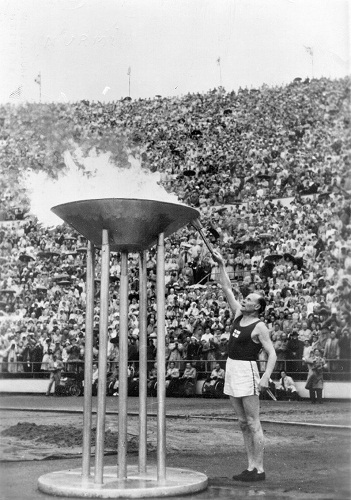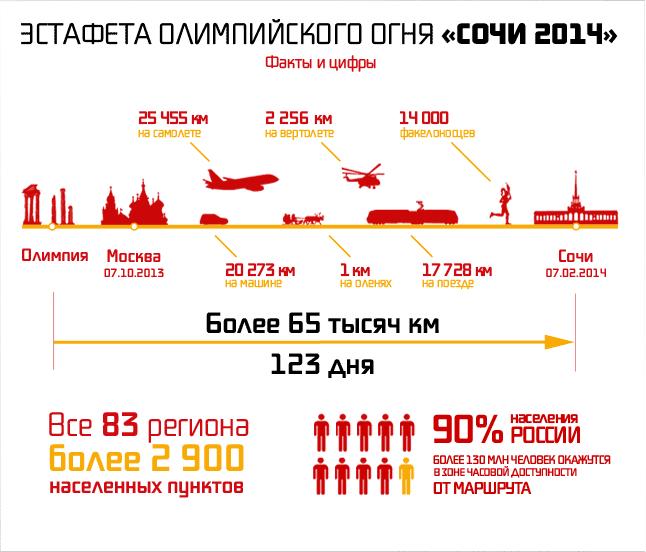XXII Olympic Winter Games 2014 in Sochi. Olympic Torch Relay
03 Oct., 2013, press release


The Olympic flame is a symbol of the Olympic Games. Commemorating the
theft of fire from the Greek god Zeus by Prometheus, its origins lie in ancient Greece, where a fire
was kept burning throughout the celebration of the ancient Olympics. The fire was reintroduced at
the 1928 Summer Olympics in Amsterdam, and it has been part of the modern Olympic Games ever since.
In contrast to the Olympic flame proper, the torch relay of modern times, which transports the flame
from Greece to the various designated sites of the games, had no ancient precedent and was
introduced by Carl Diem at the controversial 1936 Summer Olympics in
Berlin.
The tradition was reintroduced during the 1928 Games. An employee
of the Electric Utility of Amsterdam lit the first Olympic flame in the Marathon Tower of the
Olympic Stadium in Amsterdam. The modern convention of moving the Olympic flame via a relay system
from Greece to the Olympic venue began in 1936. Carl Diem devised the idea of the torch relay for
the 1936 Summer Olympics in Berlin that was organized by the Nazis under the guidance of Joseph
Goebbels. The Krupp armaments company produced the torches in wood and metal, inspired by an olive
leaf. The Olympic flame was lit by a concave mirror in Olympia, Greece and transported over 3,187
kilometres by 3,331 runners in twelve days and eleven nights from Greece to Berlin. Leni Riefenstahl
later staged the torch relay for the 1938 film Olympia. The film was part of the Nazi propaganda
machine’s attempt to add myth and mystique to Adolf Hitler’s regime. Hitler saw the link with the
ancient Games as the perfect way to illustrate his belief that classical Greece was an Aryan
forerunner of the modern German Reich. There were minor protests in Yugoslavia and Czechoslovakia on
the way, which were suppressed by the local security forces.
The Olympic
Torch today is ignited several months before the opening ceremony of the Olympic Games at the site
of the ancient Olympics in Olympia, Greece. Eleven women, representing the Vestal Virgins, perform a
celebration at the Temple of Hera in which the torch is kindled by the light of the Sun, its rays
concentrated by a parabolic mirror. The torch briefly travels around Greece via short relay, and
then starts its transfer to the host city after a ceremony in the Panathinaiko Stadium in Athens.
The Olympic Torch Relay ends on the day of the opening ceremony in the central stadium of the Games.
The final carrier is often kept unannounced until the last moment, and is usually a sports celebrity
of the host country. The final bearer of the torch runs towards the cauldron, often placed at the
top of a grand staircase, and then uses the torch to start the flame in the arena. It is considered
to be a great honor to be asked to light the Olympic flame. After being lit, the flame continues to
burn throughout the Games, until the day of the closing ceremony and celebration, when it is finally
put out.

Over the years, it has
become a tradition to let famous athletes, former athletes and/or athletes with significant
achievements and milestones be the last runner in the Olympic torch relay and have the honor of
lighting the Olympic Cauldron. The first well-known athlete to light the cauldron in the stadium was
ninefold Olympic Champion Paavo Nurmi, who excited the home crowd in Helsinki in
1952.

The Olympic torch travels
through routes that symbolise human achievement such as Parkes. As part of the 1976 relay the flame
was transmitted from Greece to the New World via satellite. Heat sensors in Greece detected the
flame, the signal was sent to Ottawa via satellite and there a laser beam lit the torch. The torch,
but not the flame, was taken into space by astronauts in 1996 and
2000.

On 29 September 2013, the
Olympic torch was lit in Ancient Olympia, beginning a seven-day journey across Greece and on to
Russia, then the torch relay will start at Moscow on 7 October 2013 before passing 83 Russian cities
and arriving at Sochi on the day of the opening ceremony, 7 February
2014.
Russian Post will mark the beginning of the Relay releasing the stamp
in the block. It depicts the emblem of Olympic torch relay of the XXII Olympic Winter Games
2014 in Sochi. In the fields of the block - Map of the Russian Federation; Torch Relay, the images
of the Moscow Kremlin and the Maritime Terminal in
Sochi.
Circulation is 120 000
st.
First day Cancellation will be at Moscow main post
office.
Coming
soon!
Preminary orders by e-mail
info@stspb.ru

